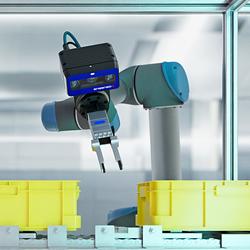Safety requirements for industrial robots: guarantee of Collaboration and Efficiency
Incorporating industrial robots in any sector is a process that requires meticulous attention to the safety of both operators and machines and operational infrastructure. Robotic safety is not a static concept but rather evolves with the development of new technologies and applications to adapt to the different challenges that arise. Challenges such as collision detection and prevention, communication and coordination between humans and robots, or adaptation to dynamic environments.
🟥WHAT ARE THE SAFETY STANDARDS IN INDUSTRIAL ROBOTICS?
ISO standards for robotics, CE marking, the use of advanced safety systems such as industrial PLCs or state-of-the-art LIDAR are part of the safety measures implemented by Robotnik to reduce the risks associated with robots.
Continuous risk assessment and the application of international standards are fundamental to ensure the quality, productivity and competitiveness of robotics manufacturers.
This article reviews the main industrial safety standards that apply to robots and the impact of these measures on real and effective human-robot collaboration.
🟥ISO ROBOT SAFETY STANDARDS
The international standards that set the minimum requirements to ensure an adequate safety level in robotic applications are those established by the International Organisation for Standardisation (ISO).
For example, the RB-KAIROS+ manipulator robot complies with ISO 3691-4, which applies to industrial mobile robots, and ISO/TS 15066, which applies to collaborative robotic arms.
Among the standards relating to industrial robots drawn up by ISO Technical Committee 299 under the heading Robotics, some of the most relevant are:
- ISO 10218-1:2011: Establishes safety requirements for industrial robots.
- ISO 10218-2:2011: Focuses on the safety of robotic systems and their integration.
These standards define concepts such as collaborative workspace, modes of operation, safety functions and risk categories. They also provide guidelines for risk analysis, selection of protective measures, validation of safety functions and operator training.
🟥CE MARKING: A HALLMARK OF ROBOT SAFETY
RB-KAIROS+ is CE marking and has been specially developed to operate safely and efficiently with people in different industrial environments.
CE marking means that industrial robots comply with the health and safety standards laid down in the European Union, guaranteeing the following:
Compliance with all legal provisions applicable to the product (directives).
It has fulfilled the relevant conformity assessment procedures.
🟥INDUSTRIAL SAFETY PLC IN ROBOTICS
The Safety PLC that integrates the RB-KAIROS+ is a Programmable Logic Controller specifically designed to guarantee safety in industrial applications. This device complies with strict international standards such as IEC 61508 (SIL) and ISO 13849 (PLd or PLe).
On the RB-KAIROS+, the Safety PLC acts as a key component to safely manage the interaction between robot and workers, monitoring safety sensors such as optical barriers, laser scanners and emergency stops. It also provides a rapid response capability to prevent risks, ensuring collaborative and safe operation. This controller also enables real-time diagnostics and monitoring, improving problem detection and reducing downtime.
🔺Features of safety PLCs:
- Constant monitoring: They detect possible failures in the system and activate automatic protection measures.
- Redundancy: Many safety PLCs have redundant systems to ensure operation even in the event of a failure.
- Interoperability: They easily integrate with other security systems, such as LIDAR sensors and light barriers.
🟥LIDAR WITH PLd CERTIFICATION
LIDAR (Light Detection and Ranging) sensors are essential for industrial robots safety. These devices use lasers to map the environment and detect objects or people in their range. In the case of the RB-KAIROS+, LIDARs with PLd (Performance Level d) certification provide the following values:
🔺Benefits of LIDAR in robotics
- Precision: It allows you to detect objects at a considerable distance with great accuracy.
- Real time: They offer instant data that allows the robot to react quickly to any obstacle or dangerous situation.
- Flexibility: Necessary for dynamic environments where conditions change frequently.
🟥INDUSTRIAL SAFETY AND COLLABORATIVE ROBOTICS
Compliance with safety regulations in robotics is certainly very important when it comes to collaborative robots that are intended to work with people.
Currently, the use of collaborative robots in industrial environments is very common and, by extension, industrial robotics regulations are also relevant for collaborative robots.
An example of the application of robot safety standards in collaborative robotics is the RB-KAIROS+ from Robotnik:
🔺Safety for human-robot interaction
The safety rules in a collaborative robot are applied as follows:
- Regulations require collaborative robots to limit their force and speed when in contact with an operator.
- Recognition of work areas through sensors and security systems to avoid collisions.
- Risk assessments that identify and mitigate potential hazards during robot deployment.
Featured Product

3D Vision: Ensenso B now also available as a mono version!
This compact 3D camera series combines a very short working distance, a large field of view and a high depth of field - perfect for bin picking applications. With its ability to capture multiple objects over a large area, it can help robots empty containers more efficiently. Now available from IDS Imaging Development Systems. In the color version of the Ensenso B, the stereo system is equipped with two RGB image sensors. This saves additional sensors and reduces installation space and hardware costs. Now, you can also choose your model to be equipped with two 5 MP mono sensors, achieving impressively high spatial precision. With enhanced sharpness and accuracy, you can tackle applications where absolute precision is essential. The great strength of the Ensenso B lies in the very precise detection of objects at close range. It offers a wide field of view and an impressively high depth of field. This means that the area in which an object is in focus is unusually large. At a distance of 30 centimetres between the camera and the object, the Z-accuracy is approx. 0.1 millimetres. The maximum working distance is 2 meters. This 3D camera series complies with protection class IP65/67 and is ideal for use in industrial environments.
